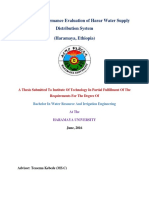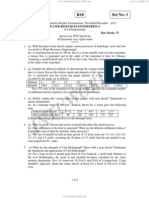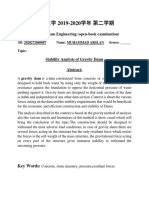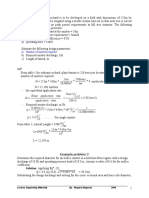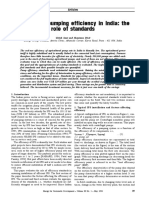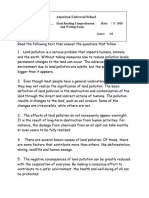Assignment 2 ANS
Uploaded by
ephremgirmaAssignment 2 ANS
Uploaded by
ephremgirmaAddis Ababa Institute of Technology (AAiT)
Department of Civil Engineering
CENG 5604: Hydropower Development
Assignment 2
All the questions are to be done in a group of 7 to 10 students. Please hand in your solution by 19 Jan. 2013.
Attempt each of the following problems and write down your solutions with all the necessary steps as neatly as
possible. Please note that unreadable answers may not be corrected.
1600
1700
1800
1900
Figure Diversion canal plant
For the above figure the following information are given:
Elevation of the head water level at intake: 1800 m above mean sea level
Elevation of the tail water level: 1600 m
Length of the power canal: 5000 m
The power canal traverses in high seepage geological setting.
Steel Penstock Length = 200 m;
Coefficient of friction f for the penstock = 0.02.
The maximum discharge to be diverted from the head water for 14 hour power production is 30 m3/s.
Overall efficiency (ɳt): 80%
Generator: frequency = 60 Hz; Number of poles = 24.
Turbine type to be used: reaction turbine.
Unit weight of water = 9.81 KN/m3
Borometric head = 10.3 m
Assume any other value if necessary.
1. Design the power canal
ANS.
Discharge capacity of the canal:
For 14 hours the discharge need is 30 m3/s. Making the power canal to operate 24 hours, the discharge
capacity of the canal would be, 30 x 14/24 = 17.5 m3/s (Note here that the conveyance efficiency is assumed
to be 100%. If the conveyance efficiency is given (say η) then the discharge capacity of the canal would be
17.5 /η).
Canal section:
Since the geology is pervious, a lined rectangular power canal is selected. The lining could be made from
Concrete, Masonry, Asphalt, etc. the decision shall be on the available construction material nearby the site.
In this example we have assumed that Masonry lining is economical to construct. For Masonry lined canal
the roughness coefficient is n = 0.015 (you can get this value from any standard canal hydraulic books).
Canal flow velocity:
The maximum (none scouring) and minimum (none silting) velocities allowed in masonry lined canal are
3.5 m/s and 0.3 m/s, respectively.
Power canal slope
Since hydropower needs maximization of power production, we will adopt the minimum velocity in the
design. The power canal bed slope could be computed from the Manning’s equation as:
0.015 2 0.32 2.025 10 5 b 2d
4/3
n 2V 2
S
A / P 4 / 3 b d / b 2d 4 / 3 b d 4 / 3
It needs an economical analysis to fix the slope of a canal as the above slope might lead to larger cross-
sectional area, here we assume the canal bed slope to be 1:1000.
The flow velocity in the canal:
1 2 / 3 1/ 2
V R S 1 / 0.015 R 2 / 3 0.0011 / 2 2.108 R 2 / 3
n
Rmin 0.327 Vmin 0.327 0.31.5 0.0537
1.5
Rmax 0.327 Vmax 0.327 3.51.5 2.1412
1.5
A bd
R
P b 2d
Any combination of b and d substituted in the hydraulic radius (R) formula above can be adopted. However,
site specific conditions might make you fix the maximum possible value of b, say it is 5 m.
A bd 5d
R
P b 2d 5 2d
2/3
5d
V 2.108
5 2d
Q V A
5d
2/3
17.5 2.108 5d
5 2 d
d 1.506m
R 0.94
R is within the recommended region, thus the adopted dimension is safe from scouring and siltation.
The velocity in the canal, V = 2.324 m/s
Free board:
Usually it is extended to 15cm to 70cm above the design water level. Thus adopt a free board of 0.404 m so
that the total lined canal depth D is 1.90m
2. The Forebay storage capacity (if needed)
ANS
The canal, designed above, have to serve for 24 hour with a discharge capacity of 17.5 m3/s; however the
discharge needed by the project is 30 m3/s for 14 hours, thus the difference (30 – 17.5) 12.5 m3/s have to
come from a temporary storage called the Forebay. Thus the Forebay capacity shall be: 12.5 x 14 x 60 x 60
= 630000 m3. Or 17.5 x 10 x 60 x 60 = 630000 m3.
3. Decide on the number of Penstocks, diameter and thickness
ANS.
The thickness of the pipe shell (s) for penstocks should be determined by: s = PD/(2ησ).
Where s = penstock shell thickness; P = internal pressure; D = pipe diameter; η = joint efficiency of welded or
riveted joint (say 90%); σ = allowable unit stress of hoop tension (1650 MPa)
Internal pressure:
Elevation of water level at the end of the power canal is the same as the maximum water level inside the
Forebay. Since uniform flow in the canal is assumed the free surface level have the same slope as the canal bed
level thus the water level at the end of the canal length (5000 m) is: 1800 – 5000 x 0.001= 1795.00 m a.m.s.l.
Elevation at the tail water level = 1600 m;
Thus the gross head of water is 1795 – 1600 = 195 m.
vo c 4 30 38.2 c
The water hammer pressure is hwm vo c c KPa
g D p 2
D p2
0.5
1 C1 D p
Note c
K sE
Since there no information given on the material strength, support condition, we could adopt a trial value of
speed of sound in water (1482 m/s) as a value of c.
38.2c 0.0382c
Thus the pressure P hwm h KPa 9.81 195 KPa 1.913 MPa
D p2 D p
2
0.0382c 0.0382c
2
1.913 D p 1.913D p
D p Dp
Thus s 2970 D p s 1.913D p2 0.0382c
2 0.9 1650MPa 2970
0.0382
2970 D p s 1.913D p2 Take E for steel is 200 GPa and K is 2.2 GPa; use pipe with
1 C1 D p
K
sE
expansion joints; C1 = 0.85.
38.2
2970 D p s 1.913D p2 EQ.1
1 0.85D p
2.2 200s
Minimum thickness (in inches), based on need for stiffness, corrosion protection, and strength requirements, is
indicated by the U.S. Department of the Interior (1967) to be: smin= (D + 20)/400 = 25.4 x (D(m)/0.0254 +
20)/400 = 2.5D+1.27 (mm).
Gordon and Penman (1979) give a very simple equation for determining steel penstock diameter for small
hydropower installations: Dp=0.72Q0.25
= 0.72 x 300.25 = 1.685 m (1.70 m) for a single penstock, s = 7.45 mm (EQ.1), smin = 5.52 mm
=0.72 x 150.25 = 1.417 m (1.45 m) for two penstocks, s = 9.35 mm (EQ.1), smin = 4.895 mm
=0.72 x 100.25 = 1.280 m (1.30 m) for three penstocks, s = 11.01 mm (EQ.1), smin = 4.52 mm
Comparing the above arrangement we require larger number of penstocks for smaller variation in diameter.
Thus adopting a single penstock is better as it requires smaller quantity of steel.
Thus adopt a single penstock having diameter of D = 1.7 m and thickness s = 8 mm.
4. Determine the maximum power output from the installation
ANS.
Net head computation:
Elevation of water level at the end of the power canal is equal to Forebay full supply level = 1795.00 m
a.m.s.l.
Tail water level = 1600 m.
Gross head = 1795 – 1600 = 195 m.
Head loss in penstock:
Qp 4Q p
Qp = Q = 30 m3/s; v p 13.22m / s ;
Ap D p2
L p v 2p
hl p f 20.95m
Dp 2g
Net Head (hn) = Gross head – head loss = 195 – 20.95 = 174.05 m.
Power = ɳρgQphn = 40978.4 KW
5. Decide on the type of reaction turbine.
ANS.
Specific speed:
Number of pair of poles will be 24/2 = 12.
60 f N P
N 300rpm; N s 5 / 4 96.06
p H
Francis turbine is suitable as 40 < NS < 452.
6. Decide on the number and capacity of reaction turbines for the installation.
ANS.
Use two Francis turbines having 45 MW capacity, one of which could be used as a stand by unit.
7. Design a scroll casing for the turbine.
Qϴ = Qϴ/(2π) = 4.775 ϴ m3/s
Velocity at the entrance:
v 0.2 2 gh 11.69m / s
Aϴ= Qϴ/v = 0.409ϴ
For propeller turbine
1 1/ 3
Q 3
30
D a 4.4 2.042 Ri 1.021m
N 300
4 A
RCase Ri 1.021 0.722
8. Determine the safe turbine setting relative to the tail water level
ANS.
y s H b c hn
c 0.04320.01N s 2 0.04
y s 10.3 0.04 174.05 3.361m
Elevation of the turbine runner = 1600 + 3.361 = 1603.361 m a.m.s.l.
9. If a simple surge chamber 5 m in diameter is provided at 50 m from the Forebay determine the maximum
up surge and down surge in the surge chamber for sudden rejection by the turbine.
ANS
Area of surge chamber, As = 19.635 m2;
Area of penstock, Atu= 2.27 m2;
Length of penstock till the surge chamber, Lt = 50m.
The velocity in the tunnel vtu = 13.21 m/s
For the rejection or demand of the turbine:
Lt At 50 2.27
z max vtu 13.21 10.14m
g As 9.81 19.635
Ltu vtu2
f
Dtu 2 g 5.24
ko 0.52 Note k o 0.7
z max 10.14
z up 2 k o2
1 ko 0.685
z max 3 9
z up 6.95m
The maximum surge level would be (1795 – 10.14 + 6.95 =) 1791.81 m a.m.s.l. thus the height of the
surge tank should be at 1791.81 plus free board.
z down
1 2k o 0.37
z max
z down 3.76m
10. Comment on using the Forebay as a surge chamber or vice versa
ANS.
In this installation designing a forebay as balancing reservoir and surge chamber would be economical. This
is because the surge chamber is close to the forebay than the turbines. By providing the surge chaber we
have protected only 50 m length of the penstock.
You might also like
- Program of Proper Maintenance and Monitoring of Physical Plant83% (6)Program of Proper Maintenance and Monitoring of Physical Plant1 page
- Design of Vertical Drop Weir PG, Example, 202083% (6)Design of Vertical Drop Weir PG, Example, 20209 pages
- Determination of Reservoir Storage Capacity100% (4)Determination of Reservoir Storage Capacity5 pages
- 4 - HE 731 - Example - Surge Tank and TurbinesNo ratings yet4 - HE 731 - Example - Surge Tank and Turbines11 pages
- 3 3 3 .2 Design Discharge .3 Stream/River Training Works: Improvement of Cross-Section Channel Rectification Dykes100% (1)3 3 3 .2 Design Discharge .3 Stream/River Training Works: Improvement of Cross-Section Channel Rectification Dykes90 pages
- The Average Monthly Flow of A Stream in A Dry Year75% (4)The Average Monthly Flow of A Stream in A Dry Year5 pages
- Arbaminch University: Water Technology Institute Department of Hydraulic Engineering Open-Channel Hydraulics Make Up Exam50% (2)Arbaminch University: Water Technology Institute Department of Hydraulic Engineering Open-Channel Hydraulics Make Up Exam2 pages
- Assignment & Project For Hydropwer Engineering100% (1)Assignment & Project For Hydropwer Engineering3 pages
- Design of Melka-Gobera Irrigation Project ESSAY100% (1)Design of Melka-Gobera Irrigation Project ESSAY61 pages
- Hydraulics and Hydrology of Hydropower Solved Problems and AssignmentNo ratings yetHydraulics and Hydrology of Hydropower Solved Problems and Assignment16 pages
- Tutorial On Sediment Transport Mechanics: April, 2020100% (1)Tutorial On Sediment Transport Mechanics: April, 202015 pages
- Irrigation Engineering Course Outline Addis College100% (1)Irrigation Engineering Course Outline Addis College1 page
- Chapter-One Quantity of Water: Arbaminch Institute of Technology100% (1)Chapter-One Quantity of Water: Arbaminch Institute of Technology41 pages
- Hydraulic Structures II (Design of Diversion and Canal Structures)No ratings yetHydraulic Structures II (Design of Diversion and Canal Structures)38 pages
- HP-I, Chapter-Four, Estimation of Water Power Potential100% (3)HP-I, Chapter-Four, Estimation of Water Power Potential112 pages
- Assignment On Concrete Dam Design and Analysis100% (1)Assignment On Concrete Dam Design and Analysis1 page
- Addis Ababa University Institute of Technology Civil Engineering Department100% (1)Addis Ababa University Institute of Technology Civil Engineering Department47 pages
- Final Exam Dam Engineering 18-12-2020 PDFNo ratings yetFinal Exam Dam Engineering 18-12-2020 PDF11 pages
- Name: - Maulid Adem Siyad ID: - 0211/12 Assignment - 2100% (1)Name: - Maulid Adem Siyad ID: - 0211/12 Assignment - 27 pages
- Section2.5.6-Theory-Part2-Examples2.15-2.16No ratings yetSection2.5.6-Theory-Part2-Examples2.15-2.1612 pages
- E5 Estimating Win Evaporation Losses P10No ratings yetE5 Estimating Win Evaporation Losses P1011 pages
- ACTIVITY 2: Layers of The Atmosphere Group No: Members:: 2. Trench ZoneNo ratings yetACTIVITY 2: Layers of The Atmosphere Group No: Members:: 2. Trench Zone3 pages
- Deionized - Demineralized Water - LenntechNo ratings yetDeionized - Demineralized Water - Lenntech1 page
- Family Health Survey Form: B. Monthly Income Per HouseholdNo ratings yetFamily Health Survey Form: B. Monthly Income Per Household7 pages
- Corporate Social responsibility-CAIRN INDIANo ratings yetCorporate Social responsibility-CAIRN INDIA3 pages
- Community Participation For Sustainable TourismNo ratings yetCommunity Participation For Sustainable Tourism2 pages
- Rivers Into Roads: The Terrestrialisation of A South-East Asian River DeltaNo ratings yetRivers Into Roads: The Terrestrialisation of A South-East Asian River Delta21 pages
- Inclined Plane Group Lever Group: Simple MachinesNo ratings yetInclined Plane Group Lever Group: Simple Machines6 pages
- Llanrwst Flooding Background Information FinishedNo ratings yetLlanrwst Flooding Background Information Finished3 pages
- Rivers and Water Quality in The Work of Brian Clarke and Ted HughesNo ratings yetRivers and Water Quality in The Work of Brian Clarke and Ted Hughes17 pages
- Hydraulics of Sewage Treatment Plants Sec-6No ratings yetHydraulics of Sewage Treatment Plants Sec-663 pages
- Glacial Eroion Processes Notes 4 5th YearNo ratings yetGlacial Eroion Processes Notes 4 5th Year3 pages
- Program of Proper Maintenance and Monitoring of Physical PlantProgram of Proper Maintenance and Monitoring of Physical Plant
- 3 3 3 .2 Design Discharge .3 Stream/River Training Works: Improvement of Cross-Section Channel Rectification Dykes3 3 3 .2 Design Discharge .3 Stream/River Training Works: Improvement of Cross-Section Channel Rectification Dykes
- The Average Monthly Flow of A Stream in A Dry YearThe Average Monthly Flow of A Stream in A Dry Year
- Arbaminch University: Water Technology Institute Department of Hydraulic Engineering Open-Channel Hydraulics Make Up ExamArbaminch University: Water Technology Institute Department of Hydraulic Engineering Open-Channel Hydraulics Make Up Exam
- Hydraulics and Hydrology of Hydropower Solved Problems and AssignmentHydraulics and Hydrology of Hydropower Solved Problems and Assignment
- Tutorial On Sediment Transport Mechanics: April, 2020Tutorial On Sediment Transport Mechanics: April, 2020
- Irrigation Engineering Course Outline Addis CollegeIrrigation Engineering Course Outline Addis College
- Chapter-One Quantity of Water: Arbaminch Institute of TechnologyChapter-One Quantity of Water: Arbaminch Institute of Technology
- Hydraulic Structures II (Design of Diversion and Canal Structures)Hydraulic Structures II (Design of Diversion and Canal Structures)
- HP-I, Chapter-Four, Estimation of Water Power PotentialHP-I, Chapter-Four, Estimation of Water Power Potential
- Addis Ababa University Institute of Technology Civil Engineering DepartmentAddis Ababa University Institute of Technology Civil Engineering Department
- Name: - Maulid Adem Siyad ID: - 0211/12 Assignment - 2Name: - Maulid Adem Siyad ID: - 0211/12 Assignment - 2
- ACTIVITY 2: Layers of The Atmosphere Group No: Members:: 2. Trench ZoneACTIVITY 2: Layers of The Atmosphere Group No: Members:: 2. Trench Zone
- Family Health Survey Form: B. Monthly Income Per HouseholdFamily Health Survey Form: B. Monthly Income Per Household
- Rivers Into Roads: The Terrestrialisation of A South-East Asian River DeltaRivers Into Roads: The Terrestrialisation of A South-East Asian River Delta
- Rivers and Water Quality in The Work of Brian Clarke and Ted HughesRivers and Water Quality in The Work of Brian Clarke and Ted Hughes

















